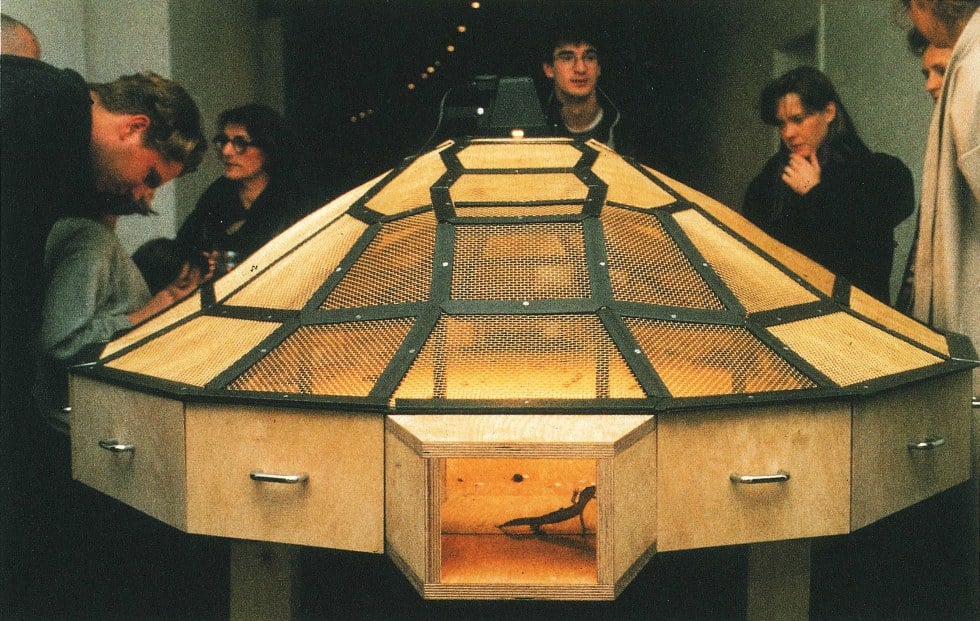
New York’s Solomon R. Guggenheim Museum has decided to pull three controversial works from an upcoming exhibition after receiving threats of violence, the institution announced in a statement late Monday night.
When “Art and China after 1989: Theater of the World,” a large-scale survey of Chinese contemporary art produced between the 1989 Tiananmen Square protests and the 2008 Beijing Olympic Games, opens October 6, it will not include Sun Yuan and Peng Yu’s Dogs That Cannot Touch Each Other (2003), Huang Yong Ping’s Theater of the World (1993), and Xu Bing’s A Case Study of Transference (1994)
“Out of concern for the safety of its staff, visitors, and participating artists, the Solomon R. Guggenheim Museum has decided against showing the art works,” wrote the museum in a statement. “Although these works have been exhibited in museums in Asia, Europe, and the United States, the Guggenheim regrets that explicit and repeated threats of violence have made our decision necessary.”
The museum did not elaborate on the nature of the threats. But it came under fire last week from animal rights activists, who said the exhibition featured animal cruelty. A Change.org petition titled “Promote Cruelty-Free Exhibits at the Guggenheim,” which called for the removal of the works, had garnered more than 600,000 signatures by Tuesday morning.
In its statement, the Guggenheim said: “As an arts institution committed to presenting a multiplicity of voices, we are dismayed that we must withhold works of art. Freedom of expression has always been and will remain a paramount value of the Guggenheim.”
The initial outcry was centered on Dogs That Cannot Touch Each Other, a seven-minute video of a performance staged by the artist duo Sun and Peng in Beijing. Eight pit bulls were placed facing one another on non-motorized treadmills. In the film, the dogs appear exhausted and agitated, attempting, yet failing, to fight each other.
“Such treadmills are typical of brutal dog fighting training regimens, and the mere positioning of animals to face each other and encourage aggression often meets the definition of illegal dog-fighting in most states,” said the American Society for the Prevention of Cruelty to Animals in a statement.
A Case of Transference is also a video documentation of a performance, in which the artist tattooed a string of fake Chinese characters and Roman letters on two pigs, which then had sex in front of an audience at a Beijing art space. (“Animals are completely uncivilized and Chinese characters are the expression of supreme civilization,” the artist told the New York Times of the work.)
The third work, which gives the exhibition its title, contains live animals. Intended as a commentary on the conflicts in human society, the piece is a large enclosure filled with live insects, amphibians, and reptiles that, as nature runs its course, fight and eat one another. The supply of animals is meant to be periodically replenished as they die during the exhibition’s run.
Theater of the World was previously the subject of controversy at the Vancouver Art Gallery in 2007. The museum removed the animals from the work after the local humane society raised concerns.
Sun Yuan and Peng Yu’s Dogs That Cannot Touch Each Other. The Guggenheim has been asked to remove the video, which features eight pit bulls on treadmills, from an upcoming exhibition. Courtesy of Galleria Continua, San Gimignano, Beijing, Les Moulins, Habana.
The American Kennel Club and People for the Ethical Treatment of Animals (PETA) both issued statements condemning the Guggenheim’s decision to show the Sun and Peng video. PETA president Ingrid E. Newkirk called on the museum’s director, Richard Armstrong, to pull both the video and Theater of the World from the exhibition.
Newkirk cited the College Art Association’s guidelines for the use of animal subjects in art, which state that “no work of art should, in the course of its creation, cause physical or psychological pain, suffering, or distress to an animal,” noting that “it is obvious to anyone watching Dogs That Cannot Touch Each Other that the dogs who were used for this video are experiencing great stress.”
“Art and China after 1989: Theater of the World” is on view at the Solomon R. Guggenheim Museum, 1071 5th Avenue, October 6, 2017–January 7, 2018.